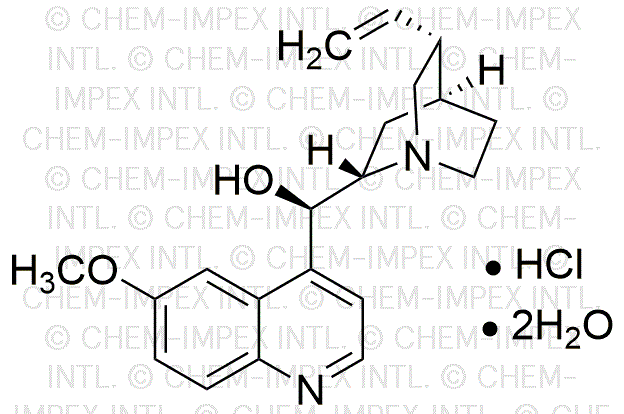Quinine hydrochloride dihydrate is widely utilized in research focused on:
- Treatment of Malaria: This compound is primarily known for its effectiveness in treating malaria, particularly in areas where resistance to other antimalarial drugs has developed. Its unique mechanism of action makes it a valuable option in combating this disease.
- Pharmaceutical Development: Researchers use quinine hydrochloride dihydrate in the development of new antimalarial medications. Its established efficacy provides a benchmark for testing new compounds in clinical trials.
- Flavoring Agent: In the beverage industry, this compound is used as a flavoring agent in tonic water and other drinks. Its distinct bitter taste is sought after by consumers, making it a popular choice for enhancing beverage profiles.
- Research on Pain Relief: Quinine hydrochloride dihydrate is also studied for its analgesic properties. It has been investigated as a potential treatment for certain types of pain, providing an alternative for patients who may not respond to conventional pain relievers.
- Veterinary Medicine: The compound finds applications in veterinary medicine, particularly for treating parasitic infections in animals. Its use in this field helps improve animal health and productivity in agricultural settings.
Información general
Propiedades
Seguridad y normativas
Aplicaciones
Quinine hydrochloride dihydrate is widely utilized in research focused on:
- Treatment of Malaria: This compound is primarily known for its effectiveness in treating malaria, particularly in areas where resistance to other antimalarial drugs has developed. Its unique mechanism of action makes it a valuable option in combating this disease.
- Pharmaceutical Development: Researchers use quinine hydrochloride dihydrate in the development of new antimalarial medications. Its established efficacy provides a benchmark for testing new compounds in clinical trials.
- Flavoring Agent: In the beverage industry, this compound is used as a flavoring agent in tonic water and other drinks. Its distinct bitter taste is sought after by consumers, making it a popular choice for enhancing beverage profiles.
- Research on Pain Relief: Quinine hydrochloride dihydrate is also studied for its analgesic properties. It has been investigated as a potential treatment for certain types of pain, providing an alternative for patients who may not respond to conventional pain relievers.
- Veterinary Medicine: The compound finds applications in veterinary medicine, particularly for treating parasitic infections in animals. Its use in this field helps improve animal health and productivity in agricultural settings.
Documentos
Hojas de datos de seguridad (HDS)
La SDS proporciona información de seguridad completa sobre la manipulación, el almacenamiento y la eliminación del producto.
Especificación del producto (PS)
La PS proporciona un desglose completo de las propiedades del producto, incluida la composición química, el estado físico, la pureza y los requisitos de almacenamiento. También detalla los rangos de calidad aceptables y las aplicaciones previstas del producto.
Certificados de análisis (COA)
Busque certificados de análisis (COA) ingresando el número de lote del producto. Los números de lote y de partida se pueden encontrar en la etiqueta de un producto después de las palabras "Lote" o "Lote".
Número de catálogo
Número de lote/lote
Certificados de origen (COO)
Este certificado de origen confirma el país en el que se fabricó el producto y también detalla los materiales y componentes utilizados en él y si se deriva de fuentes naturales, sintéticas u otras fuentes específicas. Este certificado puede ser necesario para cumplir con las normativas aduaneras, comerciales y regulatorias.
Número de catálogo
Número de lote/lote
Hojas de datos de seguridad (HDS)
La SDS proporciona información de seguridad completa sobre la manipulación, el almacenamiento y la eliminación del producto.
DownloadEspecificación del producto (PS)
La PS proporciona un desglose completo de las propiedades del producto, incluida la composición química, el estado físico, la pureza y los requisitos de almacenamiento. También detalla los rangos de calidad aceptables y las aplicaciones previstas del producto.
DownloadCertificados de análisis (COA)
Busque certificados de análisis (COA) ingresando el número de lote del producto. Los números de lote y de partida se pueden encontrar en la etiqueta de un producto después de las palabras "Lote" o "Lote".
Número de catálogo
Número de lote/lote
Certificados de origen (COO)
Este certificado de origen confirma el país en el que se fabricó el producto y también detalla los materiales y componentes utilizados en él y si se deriva de fuentes naturales, sintéticas u otras fuentes específicas. Este certificado puede ser necesario para cumplir con las normativas aduaneras, comerciales y regulatorias.


